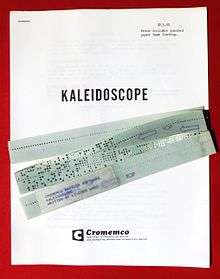Li-Chen Wang
Li-Chen Wang (born 1935) is an American computer engineer, best known for his Palo Alto Tiny BASIC for Intel 8080-based microcomputers. He was a member of the Homebrew Computer Club and made significant contributions to the software for early microcomputer systems from Tandy Corporation and Cromemco.[1]

Palo Alto Tiny BASIC
Palo Alto Tiny BASIC was the fourth version of Tiny BASIC that appeared in Dr. Dobb's Journal of Computer Calisthenics & Orthodontia, but probably the most influential. It appeared in the May 1976 Vol 1, No. 5 issue,[2] and distinguished itself from other versions of Tiny BASIC through a novel means of abbreviating commands to save memory, and the inclusion of an array variable ("@"). The interpreter occupied 1.77 kilobytes of memory and assumed the use of a Teletype Machine (TTY) for user input/output. An erratum to the original article appeared in the June/July issue of Dr. Dobb's (Vol. 1, No 6.) This article also included information on adding additional I/O devices, using code for the VDM video display by Processor Technology as an example.
Wang also wrote a STARTREK program in his Tiny BASIC that appeared in the July 1976 issue of the People's Computer Company Newsletter.[3][4]
Tandy Corporation
The original prototype TRS-80 Model I that was demonstrated for Charles Tandy to sell the idea ran Li-Chen's BASIC.[5]

Wang's mark also shows up in and on the Exatron Stringy Floppy ROM for the TRS-80 Model I. Embedded Systems columnist Jack Crenshaw calls Wang's Manchester encoding code, achieving 14K read/write speeds, a "work of art."[6]
Cromemco

The first color graphics interface for microcomputers, developed by Cromemco and called the Dazzler, was introduced in 1976 with a demonstration program called "Kaleidoscope" written by Wang. According to BYTE Magazine the program, written in 8080 assembly code, was only 127 bytes long.[7] But this short program stopped traffic on 5th Avenue in New York City.
Stan Veit was the owner of The Computer Mart in New York City. He placed a color television in his store window displaying the colorful, ever-changing kaleidoscopic patterns generated by the Dazzler and Wang's software. According to Veit: “People driving by began to stop and look – they had never seen anything like it before. In a short time the Dazzler had caused a traffic jam on 5th Avenue!” The police had to contact the building landlord and make him disconnect the television.[8]
Wang also developed "3K Control Basic" for Cromemco.[9]
Other contributions
Wang also created WSFN ("Which Stands for Nothing"), a programming language for controlling robots and published by Dr. Dobb's Journal in September 1977.[10]
In 2001 Wang was re-elected for a second term as chair of the Infrared Data Association's Technical and Test committee. In 2004 Wang was employed as Chief Technical Officer at ACTiSYS in Fremont, California, focused on IR/mobile products.
References
- Lash, Bob. "Memoir of a Homebrew Computer Club Member". Retrieved May 6, 2013.
- Wang, Li-Chen (May 1976). "Palo Alto Tiny BASIC". Dr. Dobb's Journal of Computer Calisthenics & Orthodontia, Running Light Without Overbyte. 1 (5): 12–25. Source code begins with the following six lines. TINY BASIC FOR INTEL 8080; VERSION 1.0; BY LI-CHEN WANG; 10 JUNE, 1976; @COPYLEFT; ALL WRONGS RESERVED
- "People's Computer Company" (PDF). Retrieved 25 December 2019.
- Turnbull, Pete. "Startrek.asc". Retrieved 25 December 2019.
- Welsh, David and Welsh, Theresa Priming the Pump: How TRS-80 Enthusiasts Helped Spark the PC Revolution p. 7, Copyright © 2007
- Crenshaw, Jack W. "More on Interpreters". Programmers Toolbox Column. Retrieved 5 April 2011.
- Helmers, Carl (June 1976). "About the Cover". BYTE (10): 6–7. Retrieved February 18, 2013.
- Veit, Stan (March 1990). "Cromemco - Innovation and Reliability". Computer Shopper. 3. 10 (122): 481–487.
- "3K Control Basic Instruction Manual" (PDF). Cromemco. Archived from the original (PDF) on 2013-12-22. Retrieved 2013-02-18.
- Wang, Li-Chen, "An Interactive Programming Language for Control of Robots", Dr. Dobb's Journal, 2 (10)